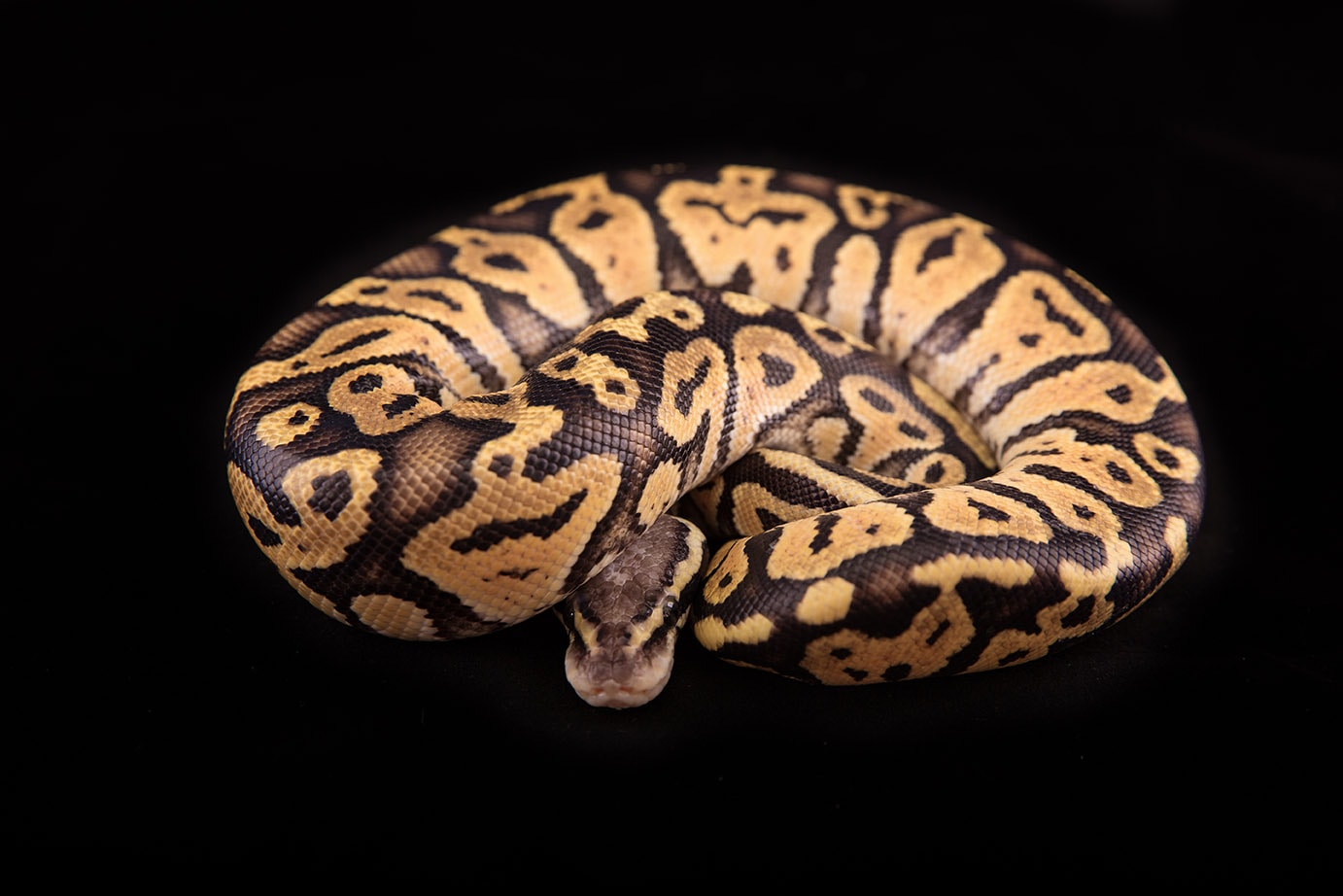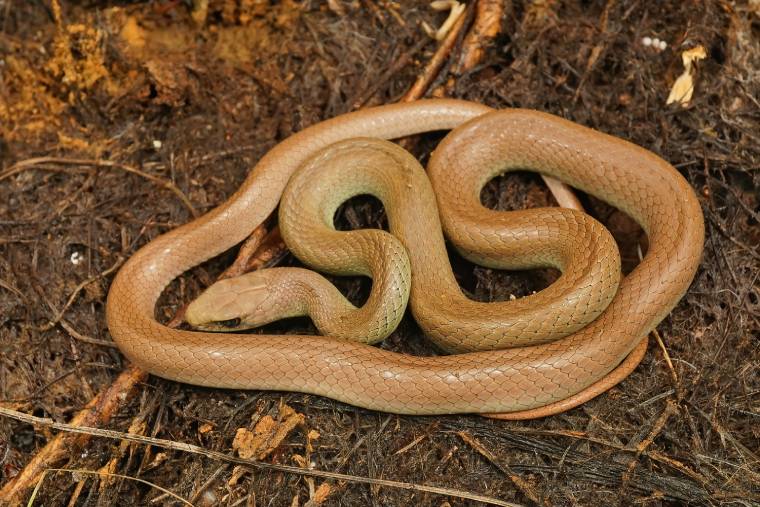
The pale yellow color of the vanilla ball python morph is combined with its capability to create brightly colored offspring. The ball python, in general, is docile, easy to care for, and makes a good pet. It is considered a good first-time snake, while its intriguing morph genetics and vibrant offspring make it equally popular with experienced keepers, too. Read on to see what’s needed to own one of these impressive reptiles.
Quick Facts about Vanilla Ball Pythons
| Species Name: | Python regius |
| Common Name: | Vanilla Ball Python |
| Care Level: | Easy to Moderate |
| Lifespan: | 30 years |
| Adult Size: | 4– 6 feet long |
| Diet: | Crickets, mice, rats |
| Minimum Tank Size: | 40 gallons |
| Temperature & Humidity | 78°–96° F temperature, 50% – 60% humidity |
Do Vanilla Ball Pythons Make Good Pets?
Vanilla ball pythons are considered good pets for experienced and first-time owners. They are docile and have low care requirements compared to other snakes. As well as being friendly with their owners, they are smaller than a lot of other species, and the vanilla is just one of the dozens of morphs, with the possible color combinations being one of the reasons that many owners take to keeping and breeding ball pythons.
It is also worth noting that the snake’s popularity means that they are readily available, and at a reasonable price. You do, however, have to ensure that you meet their care requirements and provide them with the setup they need, to ensure their happiness.
Appearance
The ball python can grow to a length of 6 feet. While this still represents a large snake and the ball does grow to be stocky, they are smaller than other python species. The standard royal python is black or brown and has brown blotches. It also has black markings on its cream belly. The vanilla is a codominant morph. A regular vanilla ball python will be brown with vanilla-colored blotches. They usually get lighter over time and young vanillas have a blushed head.
One of the reasons for the morph’s popularity is the effect it has on other morphs during breeding. Essentially, the combination of vanilla makes any other color brighter and more vibrant.
How to Take Care of Vanilla Ball Pythons
The ball python is found in western and central Africa. It lives in grasslands and forests and lives near open water where it can go to cool off during especially hot weather. Owners need to replicate the Sub-Saharan African conditions that the snake would experience in the wild.
Habitat, Tank Conditions & Setup
Tank
The vanilla ball python is a small python compared to most, but it will still grow to a length of approximately 6 feet and needs a tank to accommodate that. While young vanillas can live in a 20-gallon tank, this needs to be increased as the snake reaches maturity, so most owners opt for a larger tank, to begin with. You will need at least a 40-gallon tank. While a 55-gallon tank is considered ideal, a snake with too much tank space can become stressed, so don’t go too big.
Plastic enclosures are popular with ball python owners, because they are less expensive and lighter than glass versions, and they enable the control of temperature and humidity.
You will need some hiding boxes, a water bowl, and some branches and other pieces of décor to keep your snake happy.
Lighting
UVB lighting is not required and if you do add a bulb or other form of lighting, it needs to operate on a 12-hour cycle. Too much light for too long a period can cause distress and lead to illness.
Heating (Temperature & Humidity)
Create a temperature gradient across the tank, with the cooler end at a temperature of around 80° F and the hot side approximately 91° F and not above 93° F. A basking light or heat mat can be used to achieve the desired temperature. Alternatively, you can use a combination of the two.
Substrate
Aspen bedding is popular because it is comfortable and effective. It is also light-colored which makes it easier to spot clean because it is possible to identify poop. Other options include coconut husk, which is antimicrobial so will not grow mold, and cypress mulch.
| Tank Recommendations | |
| Tank Type: | 40-gallon glass or plastic vivarium |
| Lighting: | None required |
| Heating: | Heat pad and basking lamp |
| Best Substrate: | Aspen bedding, coconut husk, cypress mulch |
Feeding Your Vanilla Ball Python
What you feed will depend on the age and size of your python. In the wild, they would mostly eat rodents and small birds. In captivity, you can feed crickets and other insects when they are babies. Feed pinkies and fuzzies when they start to grow. The size of the prey that you offer should not be any longer than the width of the widest part of your snake’s body. Adult snakes will eat approximately every 2 weeks while young snakes eat every week or 5 days.
You should keep an eye on feeding consistency to determine whether your python is eating as usual but bear in mind that it will stop eating when shedding and may not start eating again for several days after the skin has been completely shed.
Some keepers insist that ball pythons should only eat rats, of varying sizes and ages, throughout their lives, and should not be fed mice or other prey.
| Diet Summary | |
| Fruits: | 0% of diet |
| Insects: | 0% of diet |
| Meat: | 100% of diet – small/medium-sized rodents |
| Supplements Required: | N/A |
Keeping Your Vanilla Ball Python Healthy
Keep the tank clean, ensuring that you spot clean poo every day. Completely clean the tank every 4 weeks. This means removing all décor and other items, thoroughly cleaning them, and then replacing the items back into a disinfected tank. This prevents mold and bacteria growth and can help control parasites.
Ensure that temperatures remain within the required range and that the humidity does not drop below 50%, especially when your snake is shedding. If humidity is too low, it can stop proper shedding, and this is one of the most common health complaints in all snakes.
Common Health Issues
Lifespan
The oldest recorded snake in captivity was a ball python that lived to the age of 47 years, although it is unusual for one to reach this age. You can expect an average ball python to reach approximately 30 years of age, however.
Breeding
Vanilla ball pythons are popular as breeder snakes because the vanilla morph acts to brighten other color morphs when they are combined.
They reach sexual maturity at just over 2 years of age and can remain sexually active until they are 25 years or older. The natural breeding season runs from September until November, which indicates that increasing water and humidity levels could encourage mating.
A clutch can consist of between 1 and 10 eggs, which will stick to one another and only become unstuck just before hatching. Gestation lasts approximately 50 days and the female sheds her skin 3 weeks after ovulation with the eggs being laid 4 weeks after that.
Are Vanilla Ball Pythons Friendly? Our Handling Advice
Docile and sweet-natured, the ball python is considered a friendly snake. Give a new snake approximately ten days to settle into new surroundings before handling. Use both hands when picking the snake up and do not pick it up by the tail. With a loose grip, allow the snake to explore your hands and arms, but do continue to provide support to the belly.
Shedding: What to Expect
Ball pythons will shed their skins regularly, as they grow. A healthy vanilla will shed its skin in a single piece, rather than in patches, and it will do so roughly every six weeks. You will notice its eyes turn milky just before shedding begins properly. The snake may be less inclined to be handled and may not eat during the shedding period.

How Much Do Vanilla Ball Pythons Cost?
This particular morph is quite popular and is used in other breeding programs. As such, it does not cost too much compared to some other varieties. You should be able to find a good-looking example of a vanilla morph for approximately $200.
Care Guide Summary
Final Thoughts
The vanilla ball python is a lighter-colored morph of the ball python, which is the world’s most popular pet snake. The royal python, as it is also known, is considered easy to care for, is docile in nature, and can be handled. It also takes up less room than other python species, while the vanilla not only has a unique appearance of its own but can combine with other morphs to yield brightly and uniquely colored young.
Featured Image Credit: Sanne vd Berg Fotografie, Shutterstock











